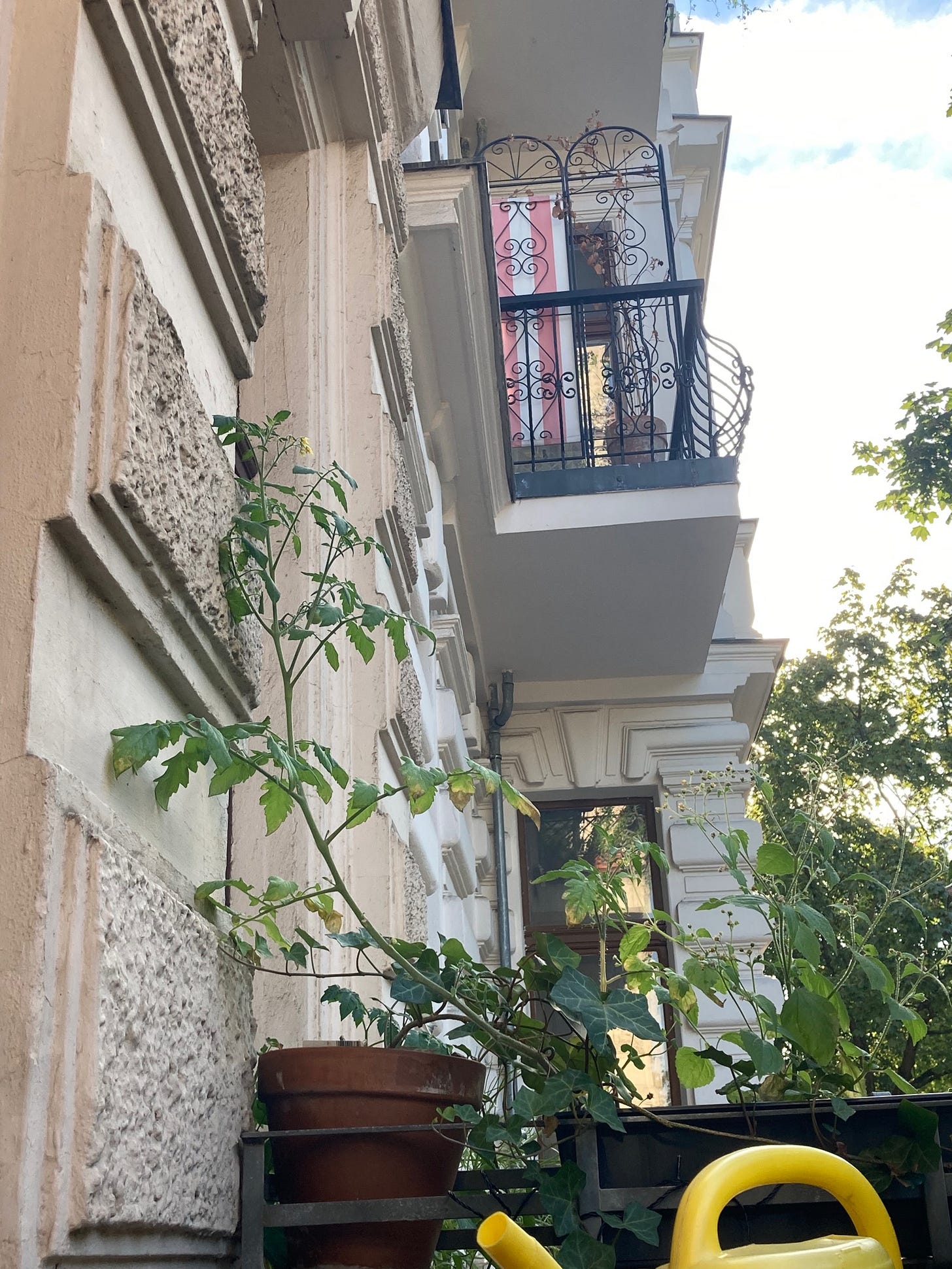Seeds are technology
Conspiring with plants to subvert the system
I recently Tweeted about a tomato plant on my balcony, which sprung from a seed that was buried in the compost and lay dormant outside all last winter.
Our balcony is in near-constant shade which limits what I’m able to grow there, but that didn’t seem to faze this plucky tomato plant. I came home from Mallorca in the summer to find it had appeared from nowhere, boldy winding its way through the other plants. It had even starting to grow fruit.
Considering it had made it this far on its own, I was kind of curious to how much I could neglect it. Aside from the occasional sympathy-watering, it received no intervention from me.
And then, nearly two months months later, I was delighted to see that the three green tomatoes had turned red. I took a photo of them for Twitter, sent a message to my family WhatsApp group to announce the news, and then - somewhat unceremoniously - ate them.
All of this is to say that I read this newsletter article by Greg Frey this morning and immediately regretted not saving those tomato seeds.
In the article, Greg talks about his own relationship with a rogue tomato plant growing in the alley near his house. But rather than eating the tomatoes he found there, he harvested them and saved the seeds to sow again next year. Doing this ensures that the genetic material of this resilient tomato is passed on, and on, and on. Thus is the cycle of life.
Today, much of the world’s biological genetic diversity is deep-frozen in seed banks, while four seed and chemical conglomerates control 60% of the world’s seed sales. This monopoly on seeds and genetic material means that all over the world commercial farmers are prevented from participating in the free economy of seeds, at the great cost of biodiversity. The fruits and vegetables that we’re most familiar with are only a tiny portion of what exists out there.
However, as he writes, this isn’t another doomer-y tale about how mankind is wrecking the earth, but a story about how seeds are a technology that offer us hope in the Anthropocene.
“By selecting seeds from thriving plants you increase the chances of their new gene combinations thriving too. You re-place the plant in the world. It means, more plants and more humans with more of a fighting chance to withstand the coming heat and unpredictability. It is a dance that we get to join, supporting the vast creativity of earth’s life into becoming something more suitable to the conditions of the present. It’s a form of cocreation that can create something truly new. In a time when the old world seems to be dying, what a profound gift.”
When I was in Portugal doing my permaculture course, I was given three bean seeds. The following summer I planted the “magic beans” on the balcony, and saved some of the seeds. This summer just gone, I planted three at my mum’s house on the South Coast of England, and last week she sent me a photograph of the next generation ready to be passed around her friends.
By saving and swapping seeds, by noticing which plants are the most resilient or which has the best fruit and then choosing to harvest the seeds of those plants, we are participating in small acts of “seed solidarity”; a part of the centuries old partnership between humans and plants. As Greg says, this is not the fabled “one small, radical thing you must do to change everything, but it is a vital piece of the puzzle”.
Anyway, this was just a short letter today to encourage you to read Greg’s piece, which is called “How to Conspire with Plants to End Capitalism” and was originally published on his own newsletter.
I promise I’ll get back to posting about something other than gardening and food again soon. Thanks for subscribing.
(more) recommendations
Speaking of tomatoes, I received a huge box of them from PermaFuture farm a few days ago. PermaFuture is a small-scale, biodiverse, permaculture farm in Brandenburg. This was the last of the tomato harvest for the year, but Berliners can still order veg boxes from Benny. Contact them on Instagram for more.
This time last week I was at Regens Unite. Were you there? Rūta Žemčugovaitė published these reflections after the workshop she facilitated there on her newsletter, Regenerative Transmissions.
Liz Eve, who has previously written for this newsletter, just published a book! Botanico, a year in the forest garden is a beautiful walk through four seasons in the Café Botanico permaculture garden in the center of the city. You can order a hard or PDF copy online. Berliner Morgenpost covered it here.
Lastly, not a recommendation but another anecdote about using seeds to subvert the status-quo; this past summer marijuana plants started appearing all over our Kiez. We first noticed a huge crop in an abandoned flower bed in the park. Unfortunately the Polizei noticed them too and eventually the plants were evicted, but they continued to appear in baumscheiben and window boxes all over the neighbourhood. It became a game to point them out. Big cheers to you, guerilla weed grower, whoever you are.
Ciao for now,
Tarn





Wondering if you might be interested in doing a story on the difference between regenerative and sustainable water https://climatewaterproject.substack.com/p/extractive-sustainable-and-regenerative